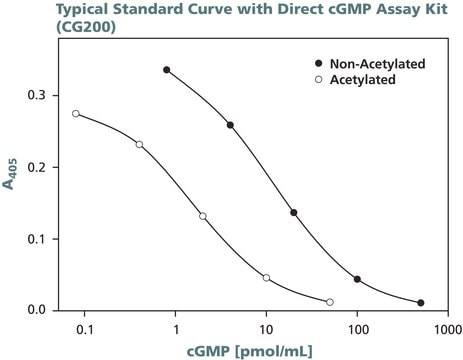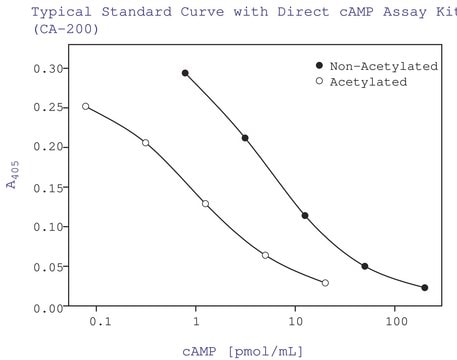CG201
cGMP Enzyme Immunoassay Kit
sufficient for 96 assays
Sign Into View Organizational & Contract Pricing
All Photos(1)
About This Item
UNSPSC Code:
12161503
NACRES:
NA.32
Recommended Products
usage
sufficient for 96 assays
Quality Level
technique(s)
ELISA: suitable
shipped in
wet ice
storage temp.
−20°C
Gene Information
human ... PRKG1(5592)
General description
cGMP Enzyme Immunoassay Kit is non-radioactive, competitive immunoassay for the quantitation of cyclic guanine monophosphate (cGMP) in biological fluids (serum, plasma, urine and saliva), tissue culture media samples or in samples containing very low concentrations of cyclic nucleotides. This kit uses a polyclonal antibody to cGMP to competitively bind cGMP or cGMP that has been covalently linked to an alkaline phosphatase molecule. The immunoassay is performed in a 96 well plate coated with anti-rabbit IgG antibody. The colored end product, produced by the addition of substrate to the wells, is read at 405 nm on a multiwell plate reader. The intensity of the color is inversely proportional to the concentration of cGMP present in the well.
Application
Non-radioactive, competitive immunoassay for the quantitation of cGMP in biological fluids (serum, plasma, urine and saliva), tissue culture media samples, or in samples containing very low concentrations of cyclic nucleotides. This kit uses a polyclonal antibody to cGMP to competitively bind cGMP or cGMP that has been covalently linked to an alkaline phosphatase molecule. The assay is performed in a 96 well plate coated with anti-rabbit IgG antibody. The colored end product, produced by the additon of substrate to the wells, is read at 405 nm on a multiwell plate reader. The intensity of the color is inversely proportional to the concentration of cGMP present in the well.
cGMP Enzyme Immunoassay Kit has been used for the quantitative determination of cyclic guanine monophosphate (cGMP) concentration in parasite tissues and mouse aortic artery homogenates. It has also been used to assess the guanylate cyclase activity.
Kit Components Only
Product No.
Description
- Acetic Anhydride 1 x 1
- Assay Buffer 2 1 x 30
- cGMP-Alkaline Phosphatase Conjugate 1 x 5
- cGMP Assay Layout Sheet 1 x 1
- cGMP EIA Antibody Rabbit Anti-cGMP 1 x 5
- 5 Cycle Logit-Log Paper 1 x 1
- Cyclic GMP Standard 1 x 0.5
- Goat Anti-Rabbit IgG Coated 96 Well Microtiter Plate 1 ea
- p-Nitrophenyl Phosphate Substrate Solution 1 x 20
- Plate Sealer 1 ea
- Stop Solution 1 x 5
- Triethylamine 1 x 2
- Wash Buffer Concentrate 1 x 30
See All (13)
Signal Word
Danger
Hazard Statements
Precautionary Statements
Hazard Classifications
Acute Tox. 2 Inhalation - Acute Tox. 3 Dermal - Acute Tox. 4 Oral - Eye Dam. 1 - Flam. Liq. 2 - Skin Corr. 1A - STOT SE 3
Target Organs
Respiratory system
Storage Class Code
3 - Flammable liquids
Flash Point(F)
12.2 °F - closed cup
Flash Point(C)
-11 °C - closed cup
Certificates of Analysis (COA)
Search for Certificates of Analysis (COA) by entering the products Lot/Batch Number. Lot and Batch Numbers can be found on a product’s label following the words ‘Lot’ or ‘Batch’.
Already Own This Product?
Find documentation for the products that you have recently purchased in the Document Library.
Identification of a novel Arabidopsis thaliana nitric oxide-binding molecule with guanylate cyclase activity in vitro
Mulaudzi T, et al.
Febs Letters, 585(17), 2693-2697 (2011)
Genistein from Flemingia vestita (Fabaceae) enhances NO and its mediator (cGMP) production in a cestode parasite, Raillietina echinobothrida
Das B, et al.
Parasitoloty, 134(10), 1457-1463 (2007)
Inhibition of MPO (Myeloperoxidase) Attenuates Endothelial Dysfunction in Mouse Models of Vascular Inflammation and Atherosclerosis
Cheng D, et al.
Arteriosclerosis, Thrombosis, and Vascular Biology, 39(7), 1448-1457 (2019)
Kamal Kumar Malukani et al.
Plant physiology, 183(3), 1345-1363 (2020-05-02)
Plant pathogens secrete cell wall-degrading enzymes that degrade various components of the plant cell wall. Plants sense this cell wall damage as a mark of infection and induce immune responses. However, the plant functions that are involved in the elaboration
Chard, T.
An Introduction to Radioimmunoassay and Related Techniques (1990)
Our team of scientists has experience in all areas of research including Life Science, Material Science, Chemical Synthesis, Chromatography, Analytical and many others.
Contact Technical Service






![Western Blocking Reagent, Solution solution, sufficient for 10 blots (11921673001 [100 cm2]), sufficient for 60 blots (11921681001 [100 cm2])](/deepweb/assets/sigmaaldrich/product/images/352/091/ef743cea-ccd8-44f1-8f3b-dec5a1e4f5d1/640/ef743cea-ccd8-44f1-8f3b-dec5a1e4f5d1.jpg)




